#long langstroth
Text

Still here!
#bees#beekeeper#beekeeping#fox#talks#honeybee#honeybees#honeycomb#honey#bee#hive#hives#long langstroth#langstroth#window#windows#access#door#natural#nature#bug#bugs#insect#insects
41 notes
·
View notes
Text
I’m majorly retooling the most recent chapter of Langstroth on Bees; below is a section I’m deleting, as it no longer fits the tone and trajectory of the section. However, I like it too well to just drop it into a deletions file and never look at it again, so here, have some beekeeping angst!
Set during Last Bow, when Holmes has taken off for America and left Watson in charge of his bees. You may think of this as a companion piece to “From Allegany,” if you like.
~
After breakfast, I suited up in Holmes' beekeeping gear and loaded his barrow with his apiarist's notebook, his smoker, and a collection of empty supers, and proceeded to the copse that held his apiary.
I was still agitated in my mind, however, a state to which his bees must have objected, for I was stung while installing the supers -- my first sting while working with Holmes' hives. I swore and stalked off beyond the edge of the copse, yanking off my gauntlet to get at the welt on my wrist, lifting my veil and twisting my arm this way and that against the sky in an attempt to see the stinger. My arms were not long enough to see the stinger without a glass, but I scraped at the cursed thing with my hive tool, succeeding only in smearing my wrist with propolis and in no way preventing the stinger from pumping its full load of venom into me. The thing smarted abominably. Holmes would have said a few words of sentimental eulogy for the bee who had died for my sins, but I could only summon up a hatred for the wretched creature and all its brethren.
All seemed futile in that moment; I lay back in the tall grasses of the Downs, just below the lip of the hollow that cradled Holmes' apiary, and sucked at my wrist in hopes of drawing the venom out. I only succeeded in coating my front teeth with propolis. Frustrated, I bit at the welt viciously, so that one pain might supersede the other. I should have gone back to the cottage for a chip of ice for my wound, or barring that, back to the apiary to close up the hive box and retrieve my beekeeping equipment, but I did neither, laying back and watching the clouds scuttle across the sky while I chewed at my wrist.
It occurred to me, as I watched the sky, that the editor of the Bee Journal might know Holmes' location; that Holmes, in communicating with him, had trusted his fellow apiarist where he had not trusted me. Or Holmes might only have sent his letter to some trusted intermediary to forward to the Journal: his brother or Captain Kell, or perhaps a now-grown Irregular. It would not be the first time he had trusted his brother or an Irregular before trusting me.
It was useless to speculate on Holmes' methods. The upshot was that Holmes did not wish me to know where he was. I would only drive myself mad brooding upon it. Mad and bee-stung, both, apparently.
But as I gazed upon the warm blue sky, I thought of Holmes, laying aside his false persona and Irish accent to write a letter about his beloved bees. Perhaps he did so even now, in the pink, cold light of an American dawn, while his criminal compatriots still slept. Did he miss his bees? Did he wish, as I did, for the opportunity to lay here beside me near his apiary, the both of us watching the clouds together? Would he have teased me for my first sting, or earnestly scolded me for it? Would he have gently tended to my wound? Would he have treated it as a badge of honour?
Even as I thought on such things, I tried to summon the bitter thought that if he was lonely in America he had no one to blame for it but himself. But I knew that to be a lie. He had never wanted this case; I had pressed him to take it. His preference would have been to bask in his retirement, with his bees before him and me at his side, as we had done the long summer before.
For a single summer, I, too, had been content with that. Another long summer stretched before me, and it seemed impossible that I should be content with it again.
By this time the welt on my wrist was bruised and riddled with tooth marks; the damage the bee had wrought on me was minor compared to what I had done to myself. Holmes would certainly have scolded me for it had he been there to see it.
I missed him, then, missed him with a fierce, simple longing, unsullied by my resentment at being left behind.
But even as I longed for him, there was no solace to be found: Holmes was in America, possibly in peril of his life, but certainly unreachable. Meanwhile, I was stranded in Sussex, pretending to be a beekeeper.
It was all wrong, all of it.
I took up my veil and gauntlet, and went to see to his bees.
13 notes
·
View notes
Text
Lorenzo Langstroth unvarnished

Lorenzo Langstroth, 1890. From Langstroth on the hive & honey bee, rev. by Dadant. 1892.
December 25th, Christmas Day, is a day for sharing and giving. It also happens to be the birthday of a man known as the father of American beekeeping: Lorenzo Langstroth, born Philadelphia, Pennsylvania in 1810. With both happy occasions in mind, Mann Library is pleased to announce a resource that we’re pretty sure students of beekeeping and its history will find a wonderful gift: a fully digitized, searchable copy of Langstroth’s handwritten personal journal. Where a researcher would have once had to make an in-person trip to our special collections reading room to attempt a deciphering of Langstroth’s (infamously difficult to read) handwriting, the journal is now freely available (and actually readable!) as both a digitized version of the original work and in a transcribed form as part of the online Biodiversity Heritage Library.
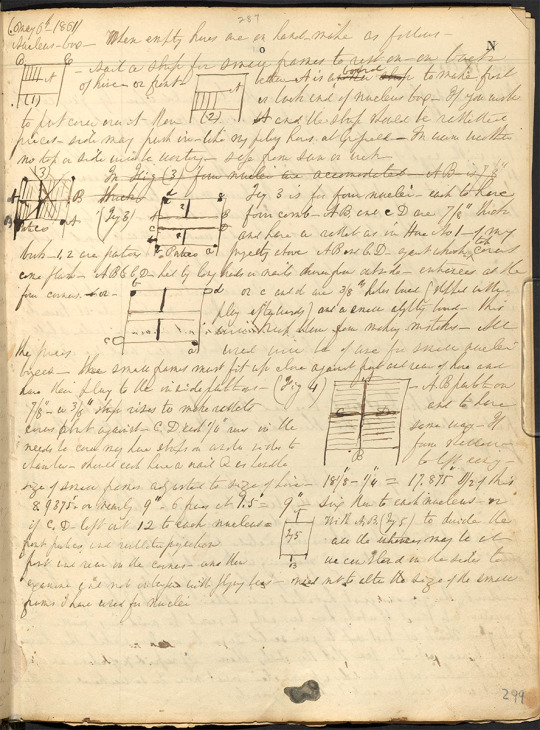
Page from "Journal on matters relating to bees, etc.," unpublished manuscript, Lorenzo Langstroth 1852-1895. in the special collections of Albert R. Mann Library, Cornell University.
For those not yet fully in the know, Lorenzo Langstroth looms large in American beekeeping history thanks to discoveries and inventions he made as a self-taught apiarist, innovations which essentially revolutionized the 19th century practice of beekeeping in North America and facilitated its development into the profitable industry of today. His guide on beekeeping, The Hive and the Honeybee, was first published in 1853 and remains in print even today. Langstroth’s story is also poignantly notable for a reason that you don’t have to a be a beekeeper to appreciate deeply: his struggles with debilitating depression, which stymied many of his professional endeavors. While working intermittently as a pastor and teacher when his mental health allowed, Langstroth found constant, life-affirming inspiration in the bee world he observed closely through the prism of the hives he kept for most of his adult life.
The history of beekeeping stretches back to prehistoric times, but when Langstroth patented his movable frame beehive in 1852 it created a worldwide revolution in the practice of keeping bees. On this page of his journal, we see the exact moment—the “aha” moment—that Langstroth landed on his brilliant insight: the significance of applying the concept of "beespace" to design hives that allow easier harvesting of honey than possible in earlier hive structures. The rest, as they say, is history.
The journal Langstroth kept is a treasure for several reasons. It provides fascinating insight into pivotal moments of beekeeping’s technological history. It is, as well, an intimate view of resilience in face of sometimes devastating mental health challenges. And last but really not least, in the comments and pet peeves that Langstroth also recorded in his ongoing notes-to-self, his off-the-record writing offers a more mundane but no less instructive tour through the day-to-day concerns—from keeping bee hives productive to the vexing challenges of protecting trade secrets and securing patents for promising new discoveries in a timely way—that would have been top-of-mind for any aspiring agricultural entrepreneur of the 19th century.
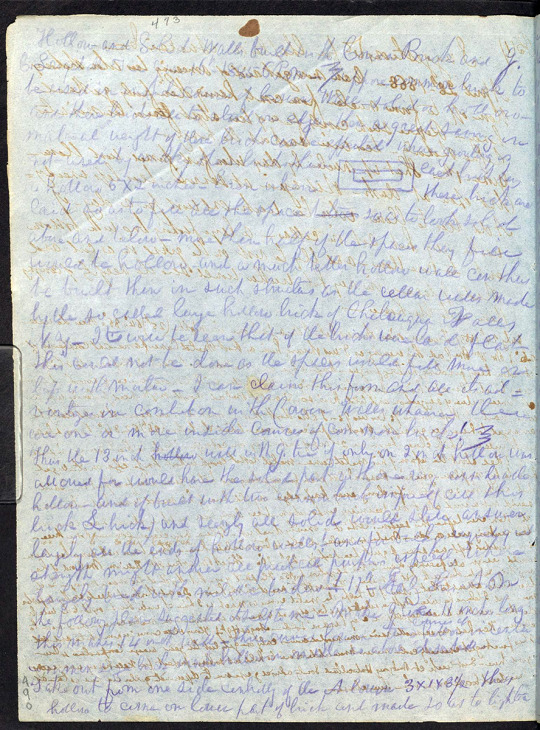
Page from "Journal on matters relating to bees, etc.," unpublished manuscript, Lorenzo Langstroth 1852-1895. in the special collections of Albert R. Mann Library, Cornell University.
The online availability of Langstroth’s journal in both its handwritten and transcribed form has been a work very long in the making. When early 20th century entomologist Everett Franklin Phillipps joined the Cornell faculty 1924, he made it his mission to establish one of the world’s most important collections of beekeeping materials—now known as the E. F. Phillips Collection at Mann Library. Recognizing the importance of one of this collections’ gems—the Langstroth journal—for the beekeeping field, Phillips began the painstaking process of transcribing 600 pages of its cramped, highly slanted script—rendered even more illegible by the frequent ink bleed-through from other pages—into easily readable typescript. The project remained unfinished at the time of Phillips passing in 1951, and others took up the work intermittently over the following decades. But it wasn’t until the epic pandemic-era national lockdown of 2020 that intrepid collections specialist Betsy Elswit finally found herself with the time needed to finish transcribing of the journal's final 200 pages. Thanks to this heroic work, a browse through the work on the Biodiversity Diversity Heritage Library today provides a look at Langstroth’s original writing with a side-by-side view of transcribed, machine-readable text. Thank you Betsy! And thank you, Reverend Langstroth, for persevering through the inspirational highs and deep lows of life to impact the practice of beekeeping so profoundly, and to leave us such a rich record of such remarkable scientific observation and personal achievement.
And with that, we leave you with our best wishes for a good, hope-filled winter holiday season!
#Langstroth#beekeeping#beekeeper#apiculture#mann library#cornell university#rare books#vintage book#archives#mental health#agricultural history#special collections#bees#honey#apiary#honey bees
11 notes
·
View notes
Text
9/11/2022
(Long post!)
I had a great time, and learned a lot, at the WV Beekeepers fall conference. It was also so great to see my friends from Women Beekeepers of WV. (The *best* group ever.) Since it's a virtual group, I usually only get to see everyone at the annual retreat.
Also had some great conversations with people I hadn't met yet.
I realized that because I was unpopular in high school, I'm always shocked and can't believe when people actually like me. (*I* generally like myself okay, but feel like an alien amongst humans.) A lady there paid me the greatest compliment. She heard I had a grandkid, and said, "I thought you were in your twenties! I was thinking of trying to set you up with my son!" No way I look that young, but I appreciate that she thought that well of me.
Bought myself a Women's Beekeepers of WV mug (made with WV foraged clay, apparently):

Conference included t-shirt, and got seeds at the seed swap:


My favorite booklets in our packs:

My favorite breakout group was Accessible Beekeeping. Gave me a lot of food for thought. I think there are things I can do to make taking care of my bees less difficult for me. I love my bees, but suiting up and standing in the hot sun, moving heavy boxes, wreaks havoc with the Chronic Fatigue. I barely make it through, and then come in and collapse the rest of the day. Way too often, I put it off because I can't face the exhaustion.
If you know someone who would benefit, search YouTube or a podcast player for "Accessible Beekeeping," or go to www.accessiblebeekeeping.org
(or just because it's interesting - did you know that there are blind beekeepers?)
In that light, I went to the Layens hive breakout group next. No heavy boxes to lift, but I wonder if the frames would be hard to repeatedly lift. (I have weak arms and poor stamina.) I'm leaning towards a long (horizontal) Langstroth, but insulated like a Layens.
And my best purchase....

These are quilt boxes for winter. I've been planning to make some, but they were $45 for the two, and I saved myself so many days of stress: researching, planning, buying materials, procrastinating because I'm too tired, and then feeling guilty about it - besides the actual build. I felt like a weight was off my shoulders and was so happy to have them. They were made by one of the county bee groups who make woodenware and sell at great prices - they're some of the nicest people!
Stayed at a friend's house the night in between - got to pet some adorable!

I only got about 6 hours of sleep the night before conference, and maybe 4 the night I was there - my friend's house was very comfortable, but my insomnia is bad enough without new surroundings. I was pretty much a zombie on Saturday - someone asked if I was melting, I slid so horizontal in my chair.
The drive home was rainy but uneventful. Was dead exhausted at that point, so took care of animals and was in bed within half an hour, 8pm. Didn't get out of bed until 10am (though with the insomnia I was awake off and on about half the time).
So glad I made it. 💙
9 notes
·
View notes
Text
Beekeeping in Eagle Mountain, Utah
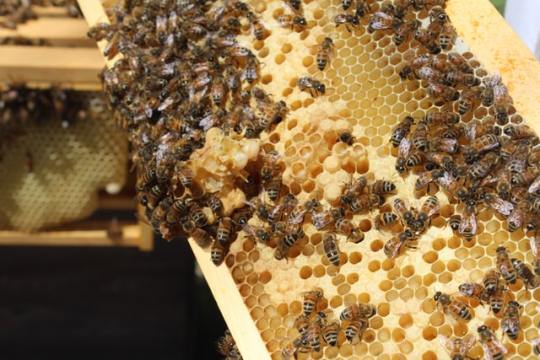
Beekeeping has become a popular urban and rural hobby. Beekeeping can be a rewarding endeavor. When we moved to Eagle Mountain back in 2013, we started several hives. I was what I would call a Beehaver, because we have a hard time getting our hives to winter over. A beekeeper is someone who can keep a hive and has the ability to have it produce year after year. The trick is knowing how to protect the hive from Utah winters as well as how to not rob too much honey so that bees have enough stored up to survive the cold years. Then you just have to pray that there is not a long heat spell with another cold spell following it.
The Bee, too, yields us its delicious Honey, and its Wax useful to a multitude of Purposes.Benjamin Fanklin - 11 June 1760
It has been a while since I have been a beekeeper, so I contacted a local beekeeper in Eagle Mountain to see how things are going with the hobby.
Eagle Mountain Resident Story
Eagle Mountain is home to a few Beekeepers. One of those Beekeepers lives along the power corridor in City Center. Gary Arnold has lived in Eagle Mountian with his wife and 3 young boys for the last 5 and a half years. If you have questions or just want to network with Gary, you can contact him via email.

Gary Arnold an Eagle Mountain Utah beekeeper
I asked Gary a few questions about his beekeeping and the experience he has had with it.
What was the reason you go into beekeeping?
I got into beekeeping during the pandemic. I was in pursuit of a new hobby/interest and something that could add some additional meaning and value to my life. I've always been fascinated by bees, so I took it to the next level. Also, who doesn't love honey?
How many hives have you kept?
I have two active hives. (A typical full-strength hive may have between 30k-70k bees at a time).
How many years have you been doing it?
Only about a year and a half.
What is the hardest part about keeping bees?
The hardest part is the unknown. Fortunately, there are a lot of resources both local and online to help guide you. You want your bees to thrive and knowing how to balance your involvement vs. letting nature do its thing can be tricky. Beekeeping isn't a particularly time-intensive hobby. It's only a few hours every other week during the summer. A little busier in the spring and fall and very little in the winter.
What are the rewards?
I've obviously become a bit of a bee nerd, so I'm definitely biased. But, learning the intricacies of the bees' life, the operations of the hive, and them coming out and seeing it all in action is simply incredible. I love to go out and just watch them go in and out of the hive, to listen, and even smell the aroma of the hive. It's all very comforting and inspiring to me. Oh and some honey is nice too.
Is there a trick you have found to have your hives winter over?
I only have one winter under my belt and one of my hives didn't make it - mediocre track record. But I think the important factors are balancing insulation and warmth with ventilation and humidity control. The bees like it warm, and they know how to keep it that way even in the winter. But wrapping them too tightly can lead to other problems. Of course, the biggest challenge to all beekeepers in North America and one of the largest factors in successfully overwintering is mite control. The Varroa Mite is one of the principal reasons we've seen many articles talking about the disappearance of hives and bees. It is a pest that brings disease and all kinds of problems to a hive. At this stage, they are unavoidable, so ensuring that you do regular checks of your hives and treating them (there are a variety of methods and opinions), is essential.
What type of hive do you have?
Both of my hives are the standard Langstroth hive (patented in 1852) which most people are familiar with. They are the square, white boxes stacked on each other. They have ten frames per box.
Were you able to harvest any honey from your hives?
I did get some honey last year! They say that you shouldn't expect honey in your first year, but I got about 2 gallons - which is actually a very small amount even for one hive :).


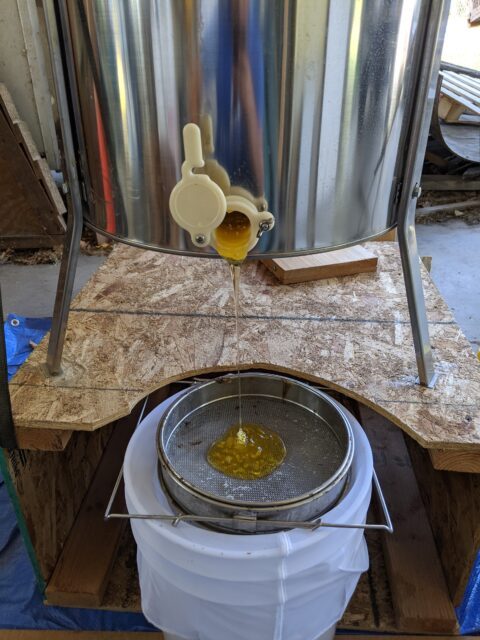



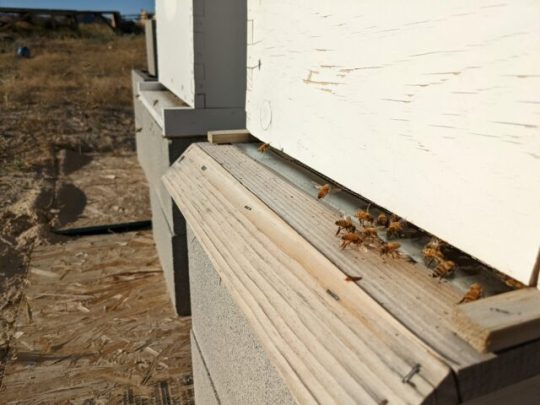
I want to thank Gary for being willing to share his experience with Cedar Valley Sentinel and the other residents of Eagle Mountain.
Hive Inspections
The Utah State University Extension program explains why inspections of hives can be important.
"The Utah Apiary Program (through the Utah Department of Agriculture and Food) conducts apiary inspections to help beekeepers diagnose pest and disease issues in their hives. They also manage and maintain hive registrations for the state of Utah. The Apiary Program is here to help, not hinder beekeepers in their endeavors. As a responsible beekeeper, it is your responsibility to register your hives, and call your county bee inspector if you have concerns."
"In 1892, beekeepers successfully lobbied the Utah territorial legislature to pass the first bee inspection act. The legislation was needed to reduce the spread of deadly foulbrood diseases, which had become rampant.
The lad allowed beekeepers to elect a honey bee inspector in every county. Later, registration was introduced to help bee inspectors communicate American foulbrood outbreaks to beekeepers at risk. These efforts significantly reduced the spread of foulbrood.
Over a century has passed since the first bee law, but inspection is still relevant today! Despite the advent of antibiotics and other advances in beekeeping, American foulbrood continues to threaten beekeepers and Utah's honey industry. Registration and inspection serve to mitigate the spread of this disease and other threats to honey bees."
We had the county inspectors look at our hives one year. They did a mite count and gave us suggestions on how to combat it. The problem we had was we waited too long to treat for mites. The colony was unhealthy when the cold season started and the bees were unable to winter over.
Utah Beekeeping Laws
I am listing the Utah beekeeping laws here, please note, that they can change at any time, I suggest you look at Utah and City code, but this is a general guideline.
R68. Agriculture and Food, Plant Industry.
R68-1. Utah Bee Inspection Act Governing Inspection of Bees.
R68-1-1. Authority. Promulgated under the authority of Section 4-11-3.
R68-1-2. Registration. Every owner or person coming into possession of one or more colonies of bees within the State of Utah shall register with the Department of Agriculture and Food in accordance with the provisions in Section 4-11-4 of the Utah Bee Inspection Act within 15 days after coming into possession of such bees.
R68-1-3. Apiary Identification. Each apiary location whether permanent or temporary shall be identified by a sign showing the owner's registration number issued by the Utah Department of Agriculture and Food at least one inch in height, easily readable and displayed in a conspicuous location in the apiary; or similar identification conspicuously displayed on one or more hive bodies within the apiary. Any apiary not so identified shall be considered abandoned and shall be subject to seizure and destruction as provided for in Section 4-11-14.
R68-1-4. Assistance in Locating Apiaries. All beekeepers shall personally assist the department or county bee inspectors in locating their apiaries, or provide accurate and detailed information as to location of all bee hives under their control or possession.
R68-1-5. Salvage Operations. All salvage operations with respect to wax, hives and appliances from diseased colonies shall be performed in a tightly screened enclosure to prevent the entrance of bees according to the following procedure: A. Frames and comb from the diseased hives shall be held for at least 30 minutes in boiling water (212 degrees F) before any wax is removed. B. After removal from the boiling water the frames must be destroyed or boiled for a minimum of 20 minutes in a solution of lye water containing no less than 10 pounds of lye (Sodium Hydroxide) for each 100 gal. of water. C. Hive bodies, supers, covers and bottom boards must be thoroughly scorched or boiled for a minimum of 20 minutes in the lye water solution.
KEY: beekeeping Date of Enactment or Last Substantive Amendment: 1987 Notice of Continuation: September 6, 2005

Beekeeping Resources (230+ Free Downloads)
These files I collected over the years when I started beekeeping. The majority of these documents have elapsed their copyright protection, which makes them free domain. If you find any errors, or documents that are copyrighted in this library, please let me know. Enjoy this free bee library provided by Cedar Valley Sentinel. If you find it useful, please share it with your fellow enthusiasts and maybe turn a few beehavers into beekeepers in the process. These files are all in pdf format and will open in another window. If you would like the entire library, let me know and we can make arrangements.
- 42 Years of Bee Keeping in New Zealand.pdf
- A Manual of Bee-Keeping.pdf
- A Manual on an Easy Method of Managing Bees.pdf
- A Practical Treatise on the Hive and Honey Bee.pdf
- A Thousand Answers to Bee-Keeping Questions.pdf
- A complete guide to the mystery and management of bees (1852).pdf
- A description of the bar-and-frame hive.pdf
- Advanced bee-culture, its methods and management (1905).pdf
- A manual of bee-keeping (1875).pdf
- A manual or An easy method of managing bees (1837).pdf
- American Bee Journal Volume 2.pdf
- American Bee Journal Volume 3.pdf
- American Bee Journal Volume 4.pdf
- American Bee Journal Volume 5.pdf
- American Bee Journal Volume 6.pdf
- American Bee Journal Volume 7.pdf
- American Bee Journal Volume 8.pdf
- American Bee Journal Volume 9.pdf
- American Bee Journal Volume 10-12.pdf
- American Bee Journal Volume 13-14.pdf
- American Bee Journal Volume 15.pdf
- American Bee Journal Volume 16.pdf
- American Bee Journal Volume 17.pdf
- American Bee Journal Volume 18.pdf
- American Bee Journal Volume 19.pdf
- American Bee Journal Volume 20.pdf
- American Bee Journal Volume 21.pdf
- American Bee Journal Volume 22.pdf
- American Bee Journal Volume 23.pdf
- American Bee Journal Volume 24.pdf
- American Bee Journal Volume 25.pdf
- American Bee Journal Volume 26.pdf
- American Bee Journal Volume 27.pdf
- American Bee Journal Volume 28.pdf
- American Bee Journal Volume 29.pdf
- American Bee Journal Volume 30.pdf
- American Bee Journal Volume 31.pdf
- American Bee Journal Volume 32.pdf
- American Bee Journal Volume 33.pdf
- American Bee Journal Volume 34.pdf
- American Bee Journal Volume 35.pdf
- American Bee Journal Volume 36.pdf
- American Bee Journal Volume 37.pdf
- American Bee Journal Volume 38.pdf
- American Bee Journal Volume 39.pdf
- American Bee Journal Volume 40.pdf
- American Bee Journal Volume 41.pdf
- American Bee Journal Volume 42.pdf
- American Bee Journal Volume 43.pdf
- American Bee Journal Volume 44.pdf
- American Bee Journal Volume 45.pdf
- American Bee Journal Volume 46.pdf
- American Bee Journal Volume 47.pdf
- American Bee Journal Volume 48.pdf
- American Bee Journal Volume 49.pdf
- American Bee Journal Volume 50.pdf
- American Bee Journal Volume 51.pdf
- American Bee Journal Volume 52.pdf
- American Bee Journal Volume 53.pdf
- American Bee Journal Volume 54.pdf
- American Bee Journal Volume 55.pdf
- American Bee Journal Volume 56-57.pdf
Read the full article
0 notes
Text
bro idk if i had a hive die over winter i don't think id be able to eat their honey. like yeah, they're stores, they're fine, most deaths wouldn't compromise the honey at all, but like emotionally? morally? no...
#im watching frederick dunn address his long lang for the first time this season and im :(#i was really excited about his long langstroth bc it made me feel like my disabled ass could beekeep#and he had saskatraz bees in it! their first winter!!! i was really excited about them too theyre a sweet breed#but the colony failed over winter from varroa going hog wild reproducing bc the queen died and a laying worker was popping drones everywher#so... he pulled smtn like 3-4 frames of solid capped honey bc it must have happened early in the season and he was like#im pulling this for me :) and im like :(#i cant imagine eating yhe stores from a dead colony....#i guess hes been doing this for like 15yrs so hes a lot less sensitive about it but still :(
12 notes
·
View notes
Photo

The Case of the Oblivious Detective by @luthienberen (moreholmes: Petr Kopl comics & The Great Mouse Detective, 10.5K, E, first time) - an entry to the recent Holmestice round, this story is a joy to read even if you’re not acquainted with Petr Kopl’s comic series. But if you are, it’s a double pleasure because the style and the humour of the comics are just spot on, plus there’s a delightful crossover with The Great Mouse Detective. A case brings Holmes and Watson to the country where they can finally come to an understanding about their relationship.
Tamerlane by methylviolet10b (ACD, 30.2K, M, friendship) - this one is also a brand new story. While it’s a part of a series, I think it can be easily read as a stand-alone. What I loved about it: deep character study, the devotion between Holmes and Watson, Wiggins and Cartwright all grown up and helping Watson to rescue Holmes, who was abducted by an old enemy. It’s an amazing action-adventure thriller from different POVs.
From Allegany by @sanguinarysanguinity (ACD, 1.2K, G, established relationship) - this one was actually recommended by @educatedinyellow in the discussion about beekeeping. I adore the way it’s written. Holmes and Watson’s love for each other which grew and matured throughout the years. They know each other so well and miss each other so much while apart. I’m looking forward to the major story of the series, Langstroth on Bees, which Sanguinity is currently writing.
Home from Exile by @gailbsanders (ACD, 1.3K, T, developing relationship) - A wonderful post-Reichenbach story where Holmes and Watson share quiet domestic moments, a newfound level of intimacy after their reunion. As always, @gailbsanders’ character study is exquisite.
One Out Of a Thousand Apologies by @teiandcookies (ACD, 1.8K, G, established relationship) - this is also a beautiful post-Reichenbach story which explores trust issues through shaving and where Holmes apologises to Watson for leaving him for three years.
Homo Faber by Saki101 (BBC & Frankenstein crossover, 13.2K, T, first time) - I enjoyed it most for the Frankenstein fix-it, since the book frustrated me very much. Sherlock is a stand-in for Victor Frankenstein, but John is at his side, so this time everything is all right for the man created via science.
Witness and Testimony by Violsva (ACD, 11.7K, E, first time) - this story is probably well-known to people who have been long in the Holmes fandom, but for me it was a delightful discovery. It’s a case fic where Watson sees a man from his club, not knowing that Holmes reciprocates his feelings. And then this man is accused of murder he didn’t commit. The only one who can testify to his innocence is Watson because they spent an evening together which is in turn can be quite compromising for them both. So Holmes takes on the case, saves the day, and gets Watson.
The Secret Sculptor by gowerstreet (ACD, 7.6K, G, established relationship) - this is also a delightful case fic which must be well-known to long-time Holmes fans. Victor Trevor appears in Holmes’s life once again, asking to solve a case. It brings up a lot of memories between them, and Watson is jealous, but he really doesn’t have to be because Holmes loves him.
Sussex Santa by Loremaiden (ACD, 705 words, G, friendship) - a sweet ficlet about the Sussex era, where Watson is a bit unshaven, and a little boy mistakes him for Father Christmas.
313 notes
·
View notes
Text
Hives, hives and hives!
Everyone is familiar with the most famous of eusoical species of bee; the European honeybee (Apis Mellifera), and for good reason. Humans have been harvesting honey from honeybees for approximately 10,000 years and it’s believed we’ve been keeping bees for as long as 7000 years ago. There are so many interesting ways in which past humans kept hives but the most recognisable and popular is the traditional hive box.
Besides the hive box, there are a many other ways in which humans today keep honeybees and in Australia our native species of stingless bee Tetragonula carbonaria. From modern takes on the tradition hive box, to more historical top-bar hives, to native hive boxes and even to bee hotels which are used to attract solitary native bees, humans love bees and love providing them with homes.
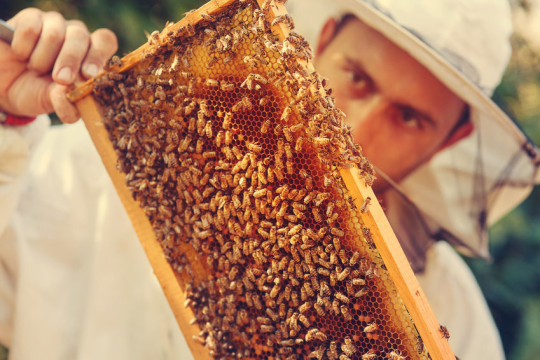
Traditional Hive Boxes
There are a few traditional hive box designs widely used globally and are similar in that they use moveable frames, have honey supers, brood boxes, a crown board and a queen excluder. They typically look and function very similar with some differences in number of frames, dimensions and where they’re used.
1. The Langstroth Hive
The most widely used hive box and common hive box (especially in Australia and the US).
2. Commercial Hive
Designed to encourage a large volume of honey in the supers and is used by commercial honey producers.
3. Dadant Hive
Very similar to the Langstroth hive but is used in France and parts of Spain.
4.The National Hive
Also similar to the Langstroth hive and is most commonly used in Britain, Europe and in the US.
5. WBC Hive
Not a very popular hive due to it being hard and inconvenient to dismantle, they have a more unique shape then just the tradition box and are used in Britain.


Alternative Honeybee Hives
1. Top-bar hive -
The top-bar hives are a modern take on the traditional honeybee hives and promote the natural shape of the honeycomb cells, allowing for larger cells that produce a larger economic yield of honey and bees wax. This is especially useful for beekeepers that have only a few hives.

The top-bar hives therefore resemble what the hive of wild or feral honeybee colony look like.They are also designed with the main body of the hive to be long and trapezoid-like in shape: like below.
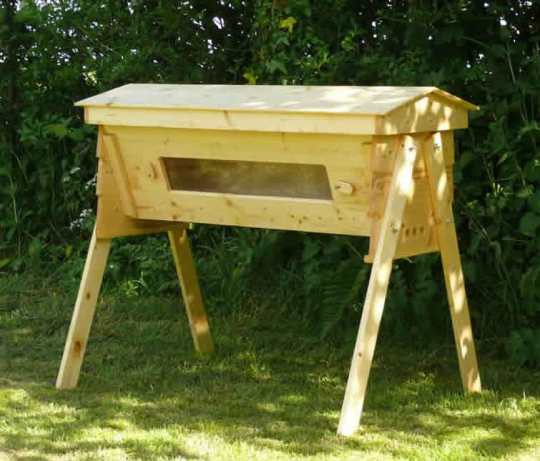
A viewing window or door is sometimes added onto the side of the hive too. This hive was designed with being easy to construct and inexpensive for the modern bee keeper. As well as producing a more natural sized-cell as opposed to framed hives.
Single bars of wooden frames are simply placed along the top of the base of the hive. The bees will then begin to fill the frame downwards like so, creating these beautiful circular frames that mound to the shape of the hive. A queen excluder is also added about half way in these hives, to separate the honey super part of the hive to the brood part of the hive.

2. Warré Hive-
Designed by Abbé Warré in 1948 Warré took the idea of the top-bar hive and designed it into a more traditional hive box. Warré published the designs in his book “Beekeeping For All” in which he advocates for far less interference with hives and bees when it comes to beekeeping.
Instead of the use of frames this hive simply uses single bars of wood like the above top-bar hives installed in the hive-body boxes that can be stacked into towers if the colony requires more space. The top of the hive is fitted with a roof and a box with cloth and wood shavings to keep the hive insulated.

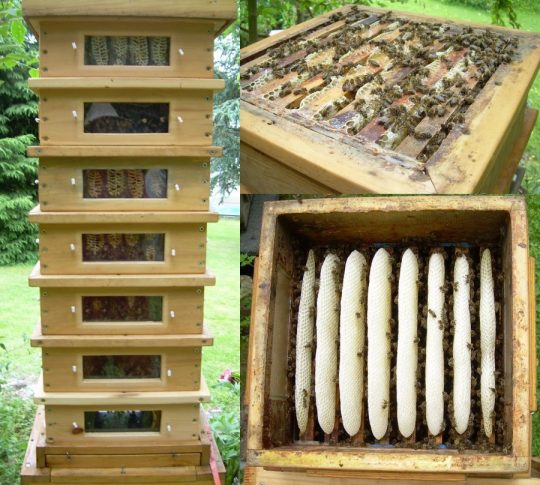
3. Log hive -
Some beekeepers believe that hive boxes are too restrictive for the bees and impacts on their health. They’ve therefore turned to a more natural form of keeping bees, in hollowed out logs!
The honey is typically stored to the back of the log hive away from the entrance. Keepers harvest this by installing a back opening or door and allows them to cut out the raw honeycomb without disturbing the bees or the brood.

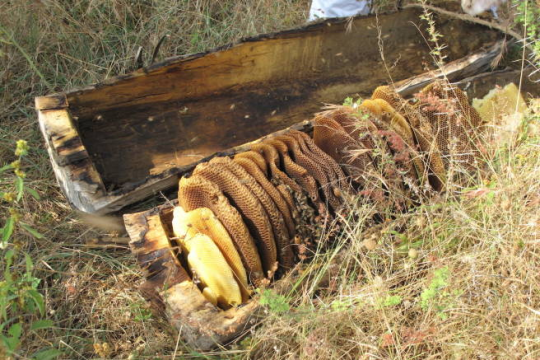
4. FLOW hive
The FLOW hive is an Australia invention with the goal of harvesting the honey without having to open the hive and manually remove the frames of honeycomb.
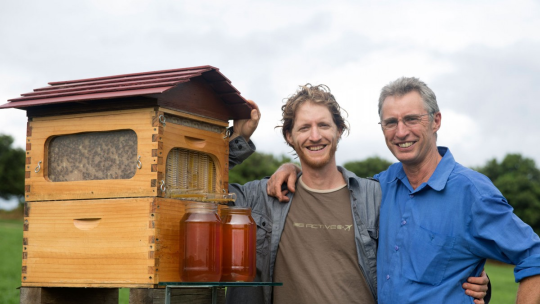
FLOW works by having frames of built-in combs, the bees are able to fill these with honey. Once full the beekeeper can turn a level to turn the honeycomb frames into the below shape. This allows the honey to flow down to the honey super, before it can be collected from the tap, all without having to open the hive and harvest the honey manually.


This hive is an efficient method of collecting honey and makes beekeeping more accessible to hobbyists and amateurs.
However it raises a few issues and risks. Mainly the use of plastics. Bees tend not to like plastic, hence why most hives are made from other materials. Plastic reduces the wax they can use to build their hive; that changes temperature and vibrates at a resonant frequency (230-270Hz) that match the bees’ sensors, allowing bees to communicate across the hive. Wax also holds the history and memory of the chemical signals used by bees.
In colder climates the honey within the hive may also crystallise blocking the FLOW hive and requiring the frames to be removed and cleaned. It was also found that the FLOW hives produced low estrogenic activities in royal jelly.
Reducing the contact humans have with their bees can also be of negative consequences. Any disease, illness or parasites in the hives may go unnoticed if the beekeeper is not opening the hive to monitor their colony.
Native Bee Hives
1. OATH - Original Australian Tetragonula Hive
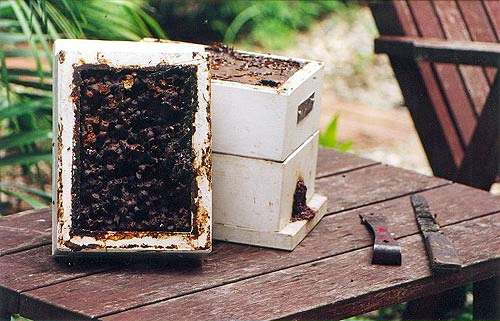
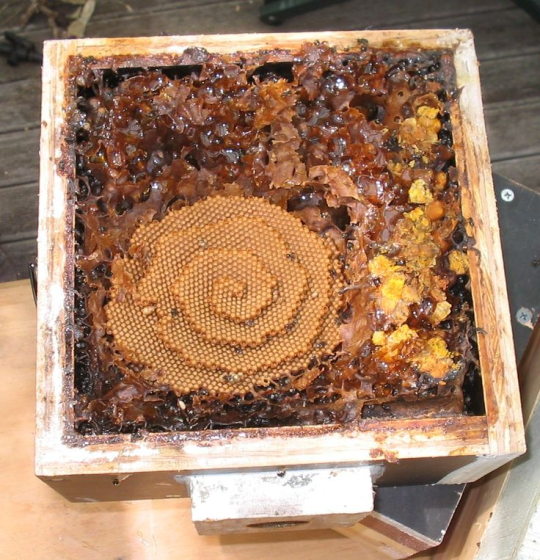


2. Solitary Bee Hotels
Solitary bees make up the largest percentage of bee species. With 90% of all the 20,000 species of bees being solitary. As such solitary bee “hives” aren’t really hives at all but nests, sometimes called bee hotels. These “hives” contain separate holes that allow for females from solitary species to barrow and lay eggs in.

There are a few different genus’ of solitary bee that will use these hotels including and not limited to; carpenter bees, green carpenter bee, reed bees, resin bees, masked bees.
The hotels are simple in design; made from holes drilled into wood or separate holes using bamboo or other hollowed out wood.

There is no need to a queen separator (as solitary species have no queens) or for brood or honey supers. As solitary bees do not produce honey. These “hives” therefore require no real keeping or maintenance and are kept primarily for encouraging native bee species and pollination (as native bees are often better at pollinating native flora species compared to honey bees!)

1K notes
·
View notes
Link
0 notes
Text
Long time no post! How is everyone??? I moved!
The bees are *mostly* alright based on my most recent “checkup” and I’m only down one and a half colonies that I knew were already weak. One of them I suspect was taken out due to a leak in the lid that made the wood damp and less insulating. They must have left very early in the season because the bottom of the hive was FULL of wax moth cocoons and eggs and cockroach poop and all kinds of nastiness. I scraped it out and didn’t see any sign of lasting mold on the wood though so it mustn’t have been too damp.
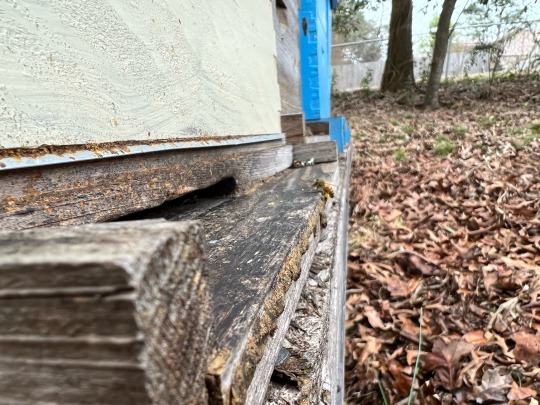
The other four langs are doing just dandy as well. All have enough bees in them to show activity at 50f and overcast so they’re apparently healthy. Already bringing in pollen too!

The super hive seems to be doing incredibly well also! They have propolized up the front of the hive in what I can only presume is an effort to manage air flow and the openness of the entrance. Since I seldom ever check the front 10 frames I suppose that’s alright, though if they are to abscond it will be a chore to get those frames out.
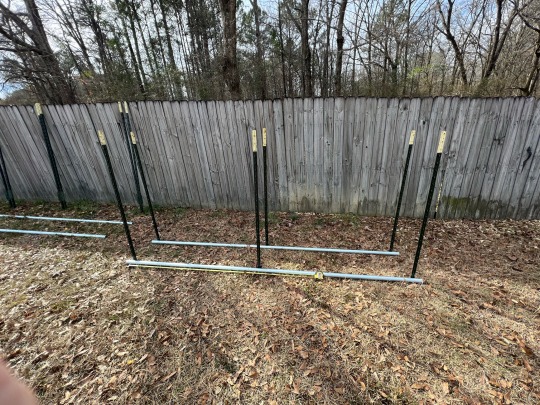

As mentioned, I did move! The bees are still at my old bee yard, but my new place has a nice open yard that I can put them in so I’ll be moving them soon hopefully. I’m setting up bee benches according to a guide I found on YouTube that is all metal and can be adjusted/moved as necessary, because the yard is unlevel everywhere. I tested several positions on each side with my full weight and they seem to hold up quite well. Though I think I may need to adjust some of them because I may have overdone the forward slope a bit. You can really see how uneven the yard is, since the benches are level.
#bees#beekeeper#beekeeping#fox#talks#honeybee#honeybees#honeycomb#honey#bee#hive#hives#langstroth#long langstroth#propolis#comb#apiculture#diy#savethebees#natural#nature#save the bees
56 notes
·
View notes
Text
"Fic Writer" Meme
(I'm not just a fic writer, and have adjusted the questions accordingly.)
Tagged by @oldshrewsburyian, thank you!
AO3 Name: sanguinity
Fandoms: Currently, the Hornblower novels and The Flight of the Heron. Previously, Strange Empire, Elementary, and a wide array of niche Holmes fandoms. And in the even more distant past, I mostly did lots of rare-fandom exchanges (Yuletide, Festivids, Kaleidoscope -- oh, how I miss Kaleidoscope!), so that between one thing and another, the long tail of my fandoms list is very long. (There was a long time that I wondered how it was even possible that people managed to have enough works in a single fandom to qualify for a remix exchange, since I had almost exclusively one-offs! But that all has changed now…)
Number of Works: 172. Most of those are fic; a couple dozen are vids; a handful are podfic. I need to go through and sort out my video and podfic hosting again; providers have decayed, morphed, and gone offline since I posted these, and I need to find new hosts for some of them.
Work I spent the most time on: Hornblower's Lost Honour, at approximately three years. (That will be GREATLY eclipsed by Langstroth on Bees if I ever finish it! Which I still intend to do someday!) Longest I spent on a vid was a year, for Something Good (Will Come From That), my multi-Holmes magnum opus.
Works I spent the least time on: Oh, good God, there are so many I whipped out in a day. A Peaceful and Beautiful Spot (FotH), Brandy and Soda (The Seven Per-Cent Solution), and Score: Q to 12 (Elementary) were all single-day works that came out very well. The Sherlock 60s, by dint of being 60 word stories, also all took something like an hour apiece. Also, the whole ceci ne pas une vid collection was made at the pace of a vidlet a day, which usually involved downloading and watching the movie, too.
Longest fic: Hornblower's Lost Honour
Shortest fic: the individual entries in Sixty for Sixty, each being a sixty word story based on one of the sixty canon Sherlock Holmes stories.
Most hits: The Sincerity of Dust (BBC Sherlock)
Most kudos: See previous. It's one of my oldest works, written at the height of a mega-fandom, and it's been wildly popular from the beginning.
Total Word Count: 726,055
Favorite Work of my Own: I feel like you're King Solomon asking me to cut my babies in half! Usually my favorite is whichever one I've reread or rewatched recently. They nearly all mean something special to me, or I wouldn't have put in the work to finish them.
Fic You Want To Rewrite/Expand On: Ugh, all the early stuff needs to be rewritten. I use too many italics, the sentence structures are awkward. I've improved SO MUCH as a writer that I almost flinch to look at them now. But I REFUSE to go back and rewrite them, I am NOT going to get entrapped in that time suck of despair and self-reproach.
As for expansion, there are a number of stories I want to write further installments to: Until Death or England Do Us Part, the Kraken series, the Any Service series, the Psychic Wolves series…
Share a Bit of a WIP or story idea you are planning on:
While visiting Ewen Cameron in the dungeons under Fort Augustus, Keith Windham forgots his pen-knife. Ewen's guards discover it the next morning when he is searched before his departure for Fort William, and via its inscription, it is traced back to Keith. Keith is court-martialed for aiding a prisoner, found guilty, and cashiered. His sword is broken, and his spirit with it.
Several years go by before he learns that the court martial had been rigged against him from the start, and that Major Guthrie had been instrumental in arranging that. With a burning desire to recover his honour, Keith boards a ship for the Highlands, the site of Guthrie's current posting, to demand satisfaction. Upon landing in Inverness, however, he makes a near-fatal miscalculation: he is robbed, stabbed, and left for dead.
When he wakes, he is in an unfamiliar room, with a very worried Ewen Cameron of Ardroy sitting vigil at his bedside…
Tagging @gniew777, @cedarboots, @verecunda, @tgarnsl, @chiropteracupola, @sailorpants, and anyone else who wishes to play!
15 notes
·
View notes
Text
Best Beekeeping Starter Kits HandyGuyPros
Technically known as apiculture, beekeeping refers to the “intentional maintenance of honeybee hives by humans.” Often, the main goal is to extract honey from the bees, among other products. It can also be done to pollinate crops or generate beeswax.
While beekeeping may seem like an interesting hobby, it is challenging, especially for starters. To make things easier, you will need to invest in the right starter kit, which will help you to get settled on the right foot.
With the tons of the choices for a beekeeping starter kit, which one should you choose? Keep on reading and we will list down some of the top options that have been praised by many people.
Top Beekeeping Starter Kits
Clueless on how to get started as a beekeeper? Increase the chances of success by having the right starter kit, including the products that will be briefly mentioned below.
Honey Keeper Bee Hive 20-Frame Complete Box Kit
This is a 20-frame kit, making it an ideal option for those who are interested in raising a large colony. Upon receiving, a bit of assembly is required, but this is surely nothing that you won’t be able to handle.
The material of choice is also excellent, which is reflective of premium quality and longevity. The foundation is made using high-quality fir wood. On the other hand, the frames are white pine wood. To make it even more durable, the top part is made of galvanized metal with a telescoping function.
While the wood itself can already prove to be durable, many of the users recommended having two coats of paint to make it more capable of withstanding outdoor conditions.
Aside from the frames, the package that you will receive will also be inclusive of entrance reducer, bottom board, queen excluder, and inner cover.
Mann Lake HK110 Basic Beekeeping Starter Kit
This is another product that can prove how beekeeping should never be a chore reserved for the pros. Even as a novice, you can succeed. This kit comes fully-assembled, so you can use it immediately right out of the box.
To provide the best bang for the buck, this kit comes with painted hive body, wood frames with foundation, bottom board with entrance reducer, telescoping cover, leather gloves, bee veil, hive tool, smoker with guard, and a book with the basics you need to know.
A lot of its users were all praises with the spacious interior, which will allow it to accommodate a bigger hive. To add, the size also allows improved air circulation for better temperature.
You will also be happy with the durability of the hive. It is created in such a way that it can withstand outdoor conditions.
Mann Lake Complete 10-Frame Bee Hive Kit
This is from the same manufacturer as the product that has been mentioned above. However, the main difference is that it does not come with accessories. But, it is already inclusive of the frames and the foundation that you will need to take care of a colony.
It comes in the form of a 10-frame fully-assembled body. The bottom board is made of solid painted wood. The entrance reducer, meanwhile, is unpainted. To add, it also has a telescoping cover with an inner cover.
As shared by the people who have used this in the past, it is quite effortless to use without having any technical knowledge. They also loved the versatility because you can effortlessly add another box with a frame as the beehive grows.
BuildABeehive 10-frame Deluxe Beehive Starter Kit
If you have always been intimidated over the thought of getting into beekeeping, this starter kit will make things a lot easier. It is user-friendly, so no need to worry even if you are a complete beginner.
The 10-piece frame design is one of its best assets, which makes it versatile. This will make it easy to expand when you want a bigger colony in the future.
As a kit, it is inclusive of almost all the supplies that you need to start on the right foot. It has wooden supers, grooved top bar frames, metal cover, plastic sheet foundation, inner cover, gloves, hive tool, and smoker and fuel.
Nonetheless, it is important to take note that it does not come fully-assembled. You need to do some work on your own, but this should not be an issue as it requires only basic carpentry skills.
Easy Bee Hive Starter Kit
Value for money – this is exactly why this product should be on the top of the list. It is inclusive of almost everything you will need -beehive super, all-purpose beehive tool, entrance reducer, bee smoker, bee veil, inner cover, bottom board, entrance cover, and telescoping metal cover, among others
The beekeeping kit will be delivered unassembled. Nonetheless, there is no need to be intimidated as it comes with detailed instructions on how you can connect the pieces. It won’t take long before it is ready!
Best of all, there is a money-back guarantee, which will guarantee your highest level of satisfaction. If you are unhappy in any way, inform the manufacturer and you will receive an unconditional refund.
Little Giant Farm and AG HIVE10KIT
Everything that you will need in one kit – such is what you can expect when you buy this product. It is a 10-frame hive that comes with a solid foundation.
Aside from the frame, it is also inclusive of frame feeder, hive tool, bee brush, smoker, veil, and gloves. You will even get a free book, which will come in handy if you are not yet that knowledgeable when it comes to beekeeping.
The versatility of this kit is also impressive. As the user, you will be free to add reinforcements as you wish, although you have to purchase them separately since the package is inclusive only of the basic components that you will need.
The deep size of the bee frame can also be a good thing. Because of this, it can have a bigger space for honeycombs. You can expect faster growth of the bees and higher honey production.
VIVO Complete Beekeeping Kit
The aesthetic appeal of this product is one of the first things that will captivate your attention. However, there is more than what meets the eye. This Langstroth-style kit is well-made and highly-functional.
The main material that is used in the frame is pine wood. While it is exceptional, it is recommended that you treat it with wood preservative or a paint that is free of chemicals. This will help to prolong its lifespan and withstand the tough outdoor conditions.
It is also a good thing that it comes with a telescopic roof. It comes with a protective metal sheet, which will protect the bees from external elements that can harm them.
VIVO BEE-KIT2 Starter Tool Kit
This is a 4-in-1 beekeeping kit that is an ideal investment for those who are just getting started in apiculture. It is affordable, so there is no reason for you to not have it included in your list of choices.
With this kit, you will already get a bee smoker with heat shield, stainless steel frame holder, j-hook tool, and beehive brush. Unlike those that have been mentioned above, however, these are just starter tools. It is inclusive of the main frame or box where you will house the bee colony.
Blisstime Beekeeping Tool Kit
Similar to the product that has been mentioned above, this is inclusive only of the tools that you will need to get started and there is no box.
To be specific, the package will be inclusive of fork tool, beehive frame grip, synthetic brush, entrance feeder, and bee smoker.
Each part of the set is made with quality in mind. The smoker, for instance, is made of durable stainless steel. The brush, on the other hand, is soft enough for ease of separating the bees from the frame.
Happybuy Beehive Kit for Beginners
The style of this beekeeping kit is pretty much similar to most of the products that have been mentioned above. It is a Langstroth-style beehive with solid construction. The main material that is used is fir wood.
It comes with ten medium and ten deep frames, which won’t require too much on your end when it comes to its assembly. The rooftop, on the other hand, comes with a telescopic design and made of galvanized metal, providing protection to the colony from external elements that can harm them.
Meanwhile, the inner cover comes with a pre-cut joint, which will make the assembly a lot easier. This cover will also provide an additional entrance while improving air circulation to keep the bees healthier.
Nonetheless, it should be noted that it does not come with the important accessories that you will need when raising bees, such as smoker and veil.
Wrap Up
While beekeeping is an exciting venture, truth be told, it is not a straightforward hobby. Among others, one thing that can make it easier would be the right starter kit, including those that have been mentioned above.
The top-rated beekeeping kits can do a lot to manage bee colonies in a breeze. Whether you are a beginner or a pro, these kits will be critical in your success in apiculture.
Source : https://handyguypros.com/best-beekeeping-starter-kits/
0 notes
Text

I'm reading this book right now. I love it. It's what I call "fiction-style nonfiction." (Or is that a thing?)
I was googling to see what a Beehaus and a traditional "Langstroth" hive looks like, and I randomly happened across a vid by the author! I found it surprising that one of his bee vids only had one like. Two now. It's a great book. Am I the only bee nerd out there? 🐝
If anyone knows of any more "fiction-style nonfiction" books about anything related to homesteading, gardening, chickens, bees, goats, et cetera, please let me know. I can't focus for long on regular nonfiction lately, and these help my motivation. (Or at least help me from tanking in the black abyss of winter despair.)
#bees
2 notes
·
View notes
Text
3 Most Common Types Of Hives For Beekeeping
As a beginner in beekeeping, you will come across several new concepts and things. You will have to go through all of them in order to get your job of beekeeping going in the right direction with the latest technologies and concepts. For starters, you will have to consider to give the best home to your bees.
People decide to keep bees because they know that they are essential for good pollination and of course, for the honey they produce. You have also decided to keep bees for the same reason. What you might not be sure about is the type of hive that will suit you the best. All beekeepers make this decision according to different factors. Here are three options of beehive for sale in Chicago for you to consider:
1. Langstroth Hive
This type of hive is also known as the ‘bee box’. It was the first ever hive to have removable frames which also made bee inspections easier for the beekeepers. A langstroth hive consists of a bottom board, one or two deep supers, one or two honey supers, an inner cover, an outer cover and frames. This style of hive is very good for easy harvesting as it makes it easier for the beekeepers to assess honey supplies and remove the desired frames. The honey-harvesting equipment is also readily available. There is even proper ventilation in this hive which is quite important in the summer days.
2. Warré Hive
This hive style has recently been becoming popular in the US. it is also known as ‘The People’s Hive.” The design of the warré hive is smaller than a langstroth hive but it contains components that are in square shape than rectangular and with boxes added to the bottom rather than to the top. The construction of this style of beehive is done in such a way that it helps to furnish moisture and control temperature. The style of this type of hive is less utilitarian and it can also look quite aesthetic in a yard or garden due to their size and peeked-roof design.
3. Top-Bar Hive
The top-bar hive operates on simplicity. In this type of hive, wooden bars along with wax strips are attached to the underside in order to encourage comb building and are suspended over a hive cavity. No artificial foundation is used. Evidence says that beekeepers in ancient Greece used baskets and pots for the same purpose. The typical top-bar hives look like long one-story wooden, slightly triangular boxes on legs along with a lid and screened access on the ends. Some people might even add a plexiglass panel to one side so that they are able to observe the colony at work.
0 notes